PC
T&P
| |
PERSONAL CONSTRUCT
THEORY & PRACTICE
|
Vol.4 2007 |
| PDF version |
| Author |
| Reference |
| Journal Main |
| Contents Vol 4 |
| Impressum |
| CELEBRATING FAY
FRANSELLA'S 80TH YEAR |
||
| Chris Thorman |
||
| First of
all, I’d like to thank Fay very
much for inviting me to speak. I just want to explain a little bit
about how
PCP developed for me over the years. When I was younger I used to hear
people
talking, articulating differently about ‘reality’ with such certainty,
what was
right, what was wrong, morality, political, social. It did seem very
confusing
to me, they seemed to be talking about different realities. When I was a young whippersnapper, I had several experiences in the middle of the night – which were not induced by any substances – which have informed me ever since, which has not been explained by anything. It was like having an altered state of consciousness, everything seemed awesomely strange, like I was a stranger in a strange world. It was like looking from a nothingness into a somethingness. As far as the world was concerned it seemed strange that anything exists, not just the world, but my own consciousness. And through these experiences I realised that even our most advanced human knowledge compared to this vast awesomeness was very limited. Beyond was an ontological, fundamental mystery. Later, much later, when I read the question “why is there something rather than nothing”, it made a lot of sense to me. So I began to search in my own way to find frameworks that touched on this experience, for years, looking for elements of these, which I realise now I was looking for a range of convenience, a range of fit, but nothing really explained it. I used to read all sorts of things like existentialism (Macquarrie, 1972), phenomenological sociology (Berger & Luckmann, 1966) – which talked about multiple realities, Tibetan Buddhism (David-Neel & Larma, 1967), works on altered states of consciousness (Brown, 1986, Chilton Pearce, 1971/2002, Grof, 1985, Kaku, 1994, tart, 1988, 1990) and anything else which seemed potentially related (Polanyi, 1958, 1969. When as a mature student I did a psychology degree course. Then, when I was looking in a bookshop, one day, I came across the book Inquiring Man by Don Bannister and Fay Fransella (1971/1993) – which was not on the course reading. I realised that here was a psychology which fitted with multiple realities, and which recognised how human beings are configured and located. I at that time was always looking at meaning and I found Osgood’s Semantic Differential (Osgood, Suci & Tannenbaum, 1961), which I was quite interested in, but when I came across Kelly’s Repertory Grid (Kelly, 1955) which worked with a person’s own elicited meaning, this seemed better. After I finished the degree course I saw a PCP foundation course at the Royal Free, run by Fay, and realised this was the psychotherapy that I wanted to do. Later the advanced course developed and then I had the opportunity to work at the PCP centre run by Fay, to teach and do therapy, then later, PCP and education and finally with David Winter in his psychology department. And over two decades I was developing what I thought of as a ‘constructivist phenomenology’. I’d just like to introduce you to something that some of you may have heard of before – a strand of something important – the story of Flatland. In the 1880’s Edwin Abbott (1884) wrote a book called ‘Flatland’, which was about flat creatures who lived on a flat plane, and they only had two-dimensional constructs (Diagram 1). 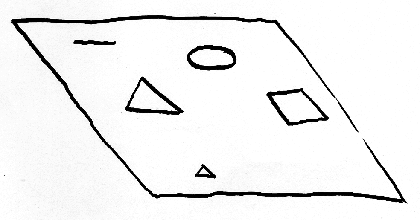 Diagram 1 Flatlanders could only see backward and forward, leftward and rightward, and they refused to believe that there was anything more, i.e. any higher dimensions. The ‘hero’, A-Square, was of course flat, and the story was a satire of Victorian society as well as an introduction to higher dimensions. According to the class of the person, the more complex they were. And so the ‘superior’ males were complex hexagons, circles etc, the ‘lower’ classes were very narrow triangles, and unfortunately women were only lines, “very dangerous to a gentleman”. Especially like the hero of the story, A-Square. |
||
| Diagram
2 |
||
| And here we have, one day, A-Square sitting
in his living room, and A-Sphere, from three dimensional space,
Spaceland (Diagram 2). Of course, the square can only see in
two dimensions so what
the
square sees is first of all a point on the carpet and then gradually in
expanding form and then an expanding circle and then a smaller circle
to a
point and he wondered was happening (Diagram 3 a). He was only seeing a
flat, two
dimensional
cross-section of the three dimensional sphere. The sphere begins to visit A-Square often, and he convinces the square that there is such a thing as a higher dimension, basically, a three-dimensional space. He does this by lifting items from a locked cabinet in Flatland into the third dimension and putting them down. And of course, to the square, the item seems to have been ‘teleported’ (Diagram 2, bottom). 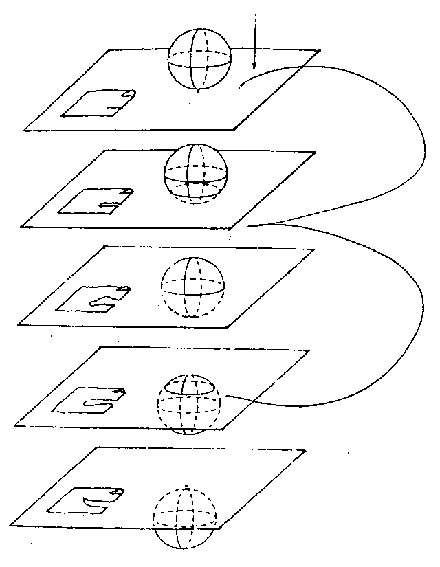 Diagram 3
 Diagram
3b. Man falling through Flatland
|
||
| Diagram
4 Diagram 5 |
||
When I am working with clients I introduce people to these analogies and also talk about the Tardis – Dr Who’s Tardis. 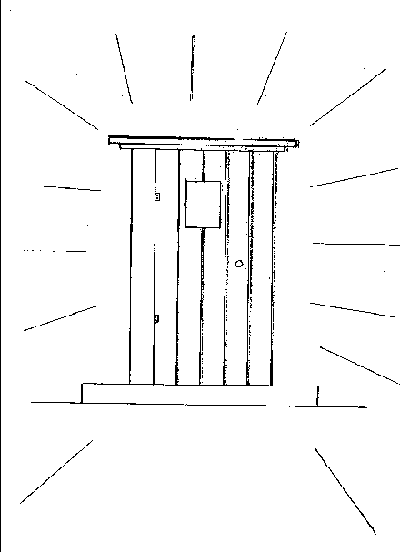 Diagram 6
Diagram 6: When Dr Who goes into the Tardis, which looks very small from the outside, when he goes inside it it’s much bigger. I also give people three pages to read on ‘invisibility’, i.e., the invisibility of interiority. We see the other person’s external features – exteriority. We see them smiling, we see them grimacing, but we don’t see their consciousness, their interiority. Analogically, this multi-dimensionality of interiority is particularly helpful for people with low self-esteem. 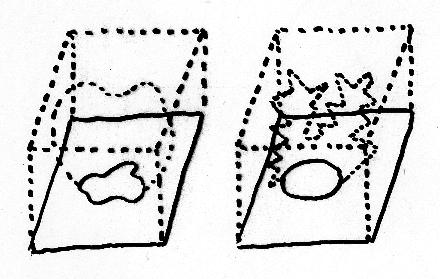 Diagram 7
In this analogy, supposing you have got somebody who is ‘physically attractive’ or symmetrical but perhaps their interiority is rather jagged, whereas perhaps a person who isn’t so ‘attractive’ or symmetrical may have a very attractive interiority (Diagram 7). And then we come to what the Existentialists call the I-Thou and the I-it relationship (Diagram 8). 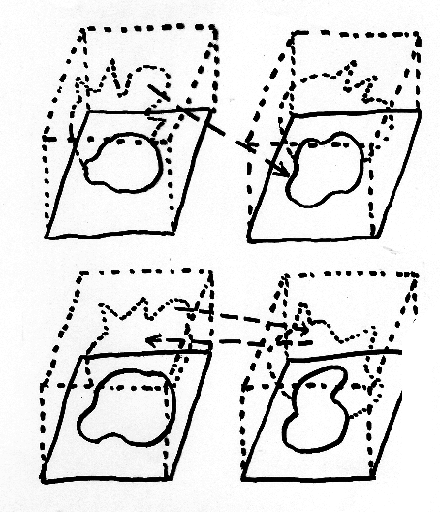 Diagram 8
Here (top diagram), one person is looking from their interiority, just purely onto the physical aspects (exteriority) of the other without taking into account sociality, without taking into account their interiority, this is an I-it relationship. Here (bottom diagram), we’ve got two people who are in an I-Thou relationship; reciprocal sociality and the recognition of the interiority within each other. I’m just explaining a few strands that I’ve woven into PCP. Another strand is the Existential idea of thrownness (Heidegger, 1962). This is the idea that we are ‘thrown’ into the world, we are thrown into a particular physical body, we are thrown into being born to particular parents, and into a particular time or place, a particular culture. 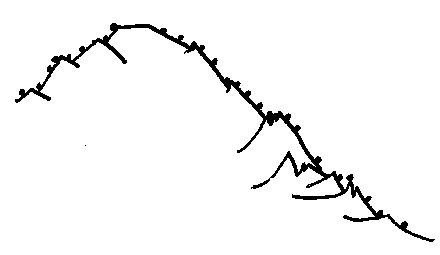 Diagram 9
Also, in terms of thrownness, is the Existential idea of ‘being there-ness’, nobody else is born for us, nobody else can die for us, nobody else is in the ‘saddle of our experience’. 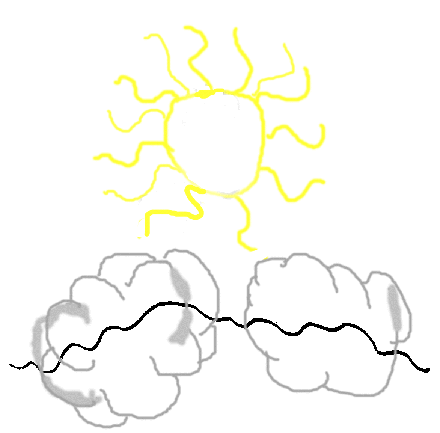 Diagram 10
Analogically, in diagram 10, is our little life’s trajectory of being there-ness through passing time involving much obscuring (as represented by the clouds) of our ‘authentic being there-ness’, with the occasional awakening. 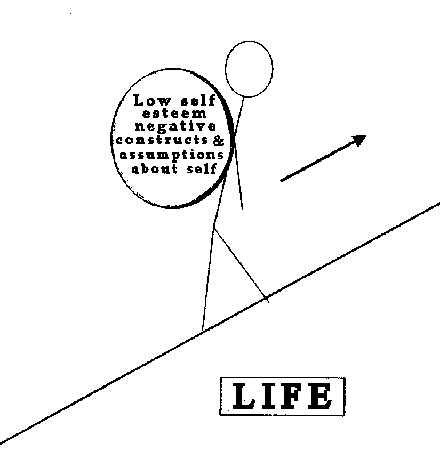 Diagram 11
In therapy, I suggest to clients that the hill in the diagram is life. The hill may be steep at times but if you add a hundred weight sack of stones onto your back – e.g. constructs relating to low self-esteem, negative construct assumptions about yourself, and negative ruminations, then it makes the uphill journey even more difficult. Prolonged negative ruminations seem to result in a negative trance-like state. |
||
| Diagram 12 concerns compassion and
understanding of the past self and the CPC cycle – circumspection,
pre-emption
and control. Very often people are very hard on themselves regarding
decisions
they have made in the past. So the analogy I give is, imagine you are
here
before the turning in the road, and somebody asks you what’s round the
corner
down this road that you’ve never been down before – you don’t know. But
once
you’ve passed by the turning in the road, you can easily look back in
retrospect and think how ‘stupid’ one was. But what that is doing in terms of the CPC cycle is phenomenologically collapsing the complexity of how you were configured and located then. I use this quite a lot with clients who are hard on themselves, to try to encourage them to be more compassionate and understanding of their past self. So that they look phenomenologically with ‘no blame’, a bit like Kelly’s suspending one’s judgement, or phenomenologically ‘bracketing’. 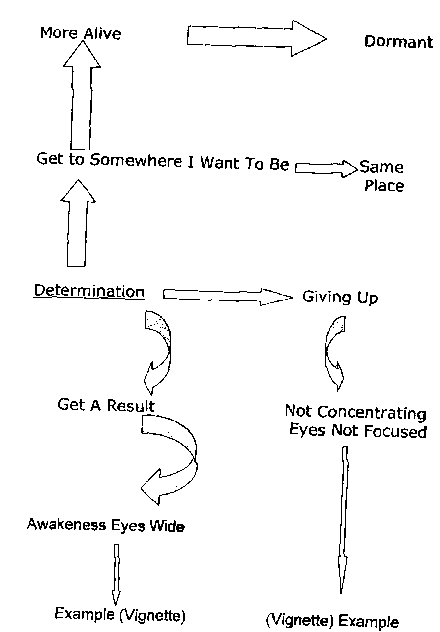 Diagram 13
I asked them if you “got somewhere where you wanted to be” where ultimately would this take you to in your life and in this case it is to feel “more alive”. In demonstrating this process one is sharing some of the theory of PCP so that the client gets to know about the hierarchical nature of our human construct systems and what superordinancy and subordinacy is, as well as some other terms. This is something I find useful in practice. Something I come across often is a negative superordinate but this is never gained by laddering up the non preferred pole, something one always teaches in training personal construct therapists – do not ladder up the non preferred pole. But, if you listen to the person for quite a while, you often, through dialogue, begin to sense a negative superordinate construct. 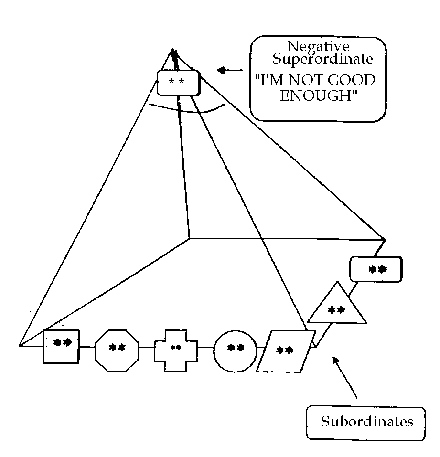 Diagram 14
For example (Diagram 14), a negative superordinate might be “I’m not good enough”, then you can explain to a client that this one negative message (**) at the superordinate level can generate a multiplicity of phenomena in their on-going stream of consciousness. For example, negative thoughts, feelings, sensations, images, memories, and what I ask people to do is to observe how this superordinate ‘message’ (**) manifests at the subordinate ‘gross mental content’ level. The different shapes at the bottom of the pyramid represent negative thoughts, feelings, sensations etc but still have the superordinate pattern (**) within them. Kelly’s technique in his self-characterisation of ‘reflection against context’ is useful here, that is, for them to reflect any negative thoughts, feelings, sensations etc against this one negative superordinate construct. So what this begins to do is bring things together for them, so that they can see that a multiplicity of negative phenomena is connected, and then we can explore where this negative superordinate came from in terms of a ‘message’ from another or others. The next step then is to de-construct and relativise the message and the sender of the message. 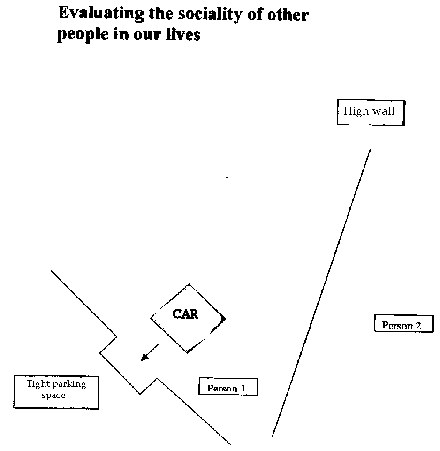 Diagram 15. Evaluating
the sociality of other people in our lives
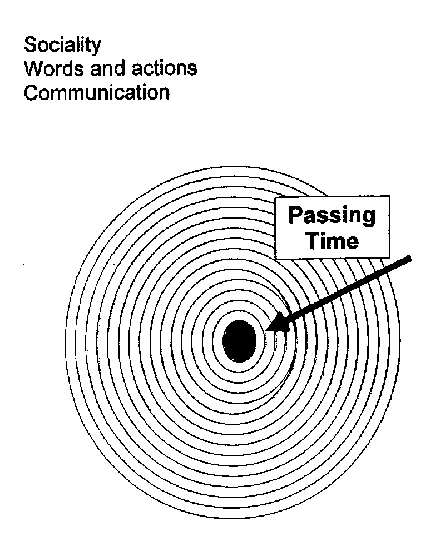 Diagram 16 This means that any new people have to earn the trust of the client through passing time and the client now has a mental map to evaluate both new people but also people they already know. Because, quite a lot of people, particularly those with low self-esteem let other people in too quickly, they get hurt and feel betrayed. 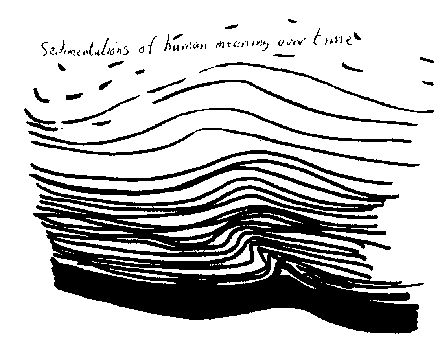 Diagram 17: Sedimentations
of human meaning over time
Diagram 17 analogically shows the sedimentation of meaning over passing time, like Kelly’s experience corollary regarding replication, the more something is experienced, the more it gets sedimented and consolidated and often reified, so here we have the idea of ‘thematic resonation’, i.e. similar themes sedimenting through time. Supposing a person has a certain experience, maybe an unpleasant experience, it sets up a configuration, a multi-level configuration, because construing is thinking, feeling, sensating – is multi-levelled. 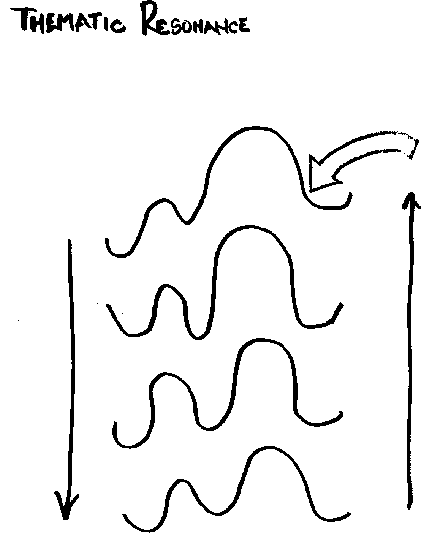 Diagram 18
And if, later on, they have a similar experience, although the content may be different, thematically it may set off the same resonation and it is going to chime with the earlier one (diagram 18). So it might originate in the family, then recur at school, and later, at work or in a relationship. It always produces the same thematic resonance. Later, one negative event could trigger the thematic resonation off again. For Kelly, there is not a great difference between therapy and education. To me, where it is appropriate to share some of the terms from personal construct psychology with clients, this is important because they feel they are being treated like intelligent people. I suggest to clients that therapy is also self-development, for example, I’ve been running a therapeutic group recently, which has been framed as a course using these ideas. Apart from the above, I ask participants, especially when they are feeling negative in their daily lives to observe their stream of consciousness with ‘no blame’, i.e. to try and observe from a gentle superordinate level their subordinate on-going manifest content. With PCP, we do explore the past, to understand how a person’s past impacts upon their present phenomenology and psychology. So we include the past, how it impacts upon the present. So we can encourage compassion and understanding for the past self but also care of the future self. I usually ask clients if they can do two self characterisations, one looking at themselves as they are now, and the other how they would like to become. This later gives a sense of direction, which is very important and can lead to work concerning positive meaning for the future. You get a direction for that person’s life. 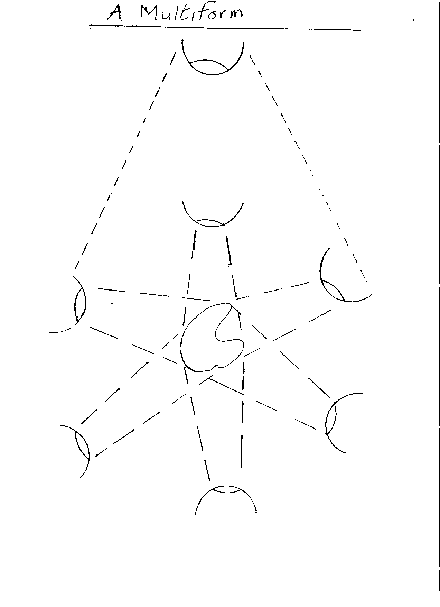 Diagram 19: A multiform
Diagram 19 analogically represents ‘a multiform’. A multiform can be defined as different construers perspectives focused upon ‘the same’ thing, object, event, situation, or person etc. For example, a psychiatric case meeting with different professionals’ perspectives, the family’s perspective and the client’s perspective, or the perspectives of policy-makers and the multi perspectives of the recipients of the policy, construing this policy, or different perspectives in an organisation, e.g. different departments etc. In the diagram we notice that there is a superordinate position, which comes about through the conceptualisation of the multiform, i.e. the conceptualisation can lift us to a superordinate level which subsumes all the perspectives, acknowledging the range of convenience for each person dwelling within that perspective and we can also explore the advantages and disadvantages of each perspective. Finally, in terms of advancing PCP philosophically we can recognise that all creature-beings construe according to their phylogenetic – species-specific – structuring. As human beings we are also a species who construes the world through our human constructions. Our Human Trajectory has generated highly advanced constructions – largely derived from a three dimensionally contexted world – but we are still HUMAN-CENTRIC. However, and wherever we construe we codify and chunk-up ‘Reality’ in humanised – homonized – terms. Beyond ALL our human constructions lies a STRANGE HORIZON. |
||
| REFERENCES | ||
| Abbott, E. A. (1884). Flatland. A romance of
many dimension. Bannister, D., Fransella, F. (1971/1993). Inquiring Berger, P., Luckmann, T. (1966). The social construction of reality. Brown, D. (1986). The stages of meditation in cross cultural perspective. In K. Wilber, K. (1986). Transformations of consciousness. Chilton Pearce, J. (1971/2002) The crack in the cosmic egg. David-Neel, A., Larma, Y. (1967). The secret oral teachings in the Tibetan Buddhist sects. Grof, S. (1985). Beyond the brain, birth death and transcendence in psychotherapy. SUNY. Heidegger, M. (1962). Being and time. (translated by Macquarrie, J & Robinson, E). Kaku, M. (1994). Hyperspace, A scientific odyssey through parallel universes, time warps and the tenth dimension. Kelly, G. A. (1955). The psychology of personal constructs. Macquarrie, J. (1972). Existentialism. Osgood, C. E., Suci, G. J. & Tannenbaum, P. H. (1957). The measurement of meaning. Polanyi, M. (1958). Personal knowledge. Polanyi, M. (1969). Knowing and being. Rucker, R. (1985). The fourth dimension, and how to get there. Tart, C. (1988). Waking up. Element books Tart, C. (1990). Altered states of consciousness. 3rd Edition. Harper. Thorman, C. (c.2003) Strange horizon. Contemplations on existence and human existence (Unpublished manuscript). |
||
| The article is based
on a talk given at the conference on 'PCP: a personal story' organised
by
the Centre for Personal Construct at the |
||
ABOUT THE
AUTHOR Chris
Thorman is a chartered counselling
psychologist and
UKCP registered psychotherapist. Three days a week he works in the
psychological therapy services as a Senior Psychotherapist for Barnet, Chris
Thorman is a chartered counselling
psychologist and
UKCP registered psychotherapist. Three days a week he works in the
psychological therapy services as a Senior Psychotherapist for Barnet, Email: Chris.Thorman@BTinternet.com click on photo to enlarge |
||
| REFERENCE Thorman, C. (2007). Celebrating Fay Fransella's 80th year. Personal Construct Theory & Practice, 4, 15-26 |
||
| Received: 6 November 2006 – Accepted: 10 November 2006 |
||
ISSN 1613-5091
| Last update 22 September 2007 |